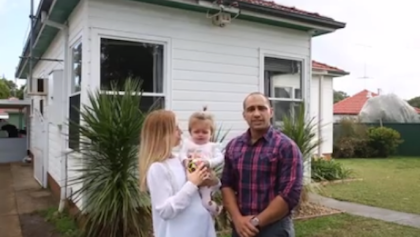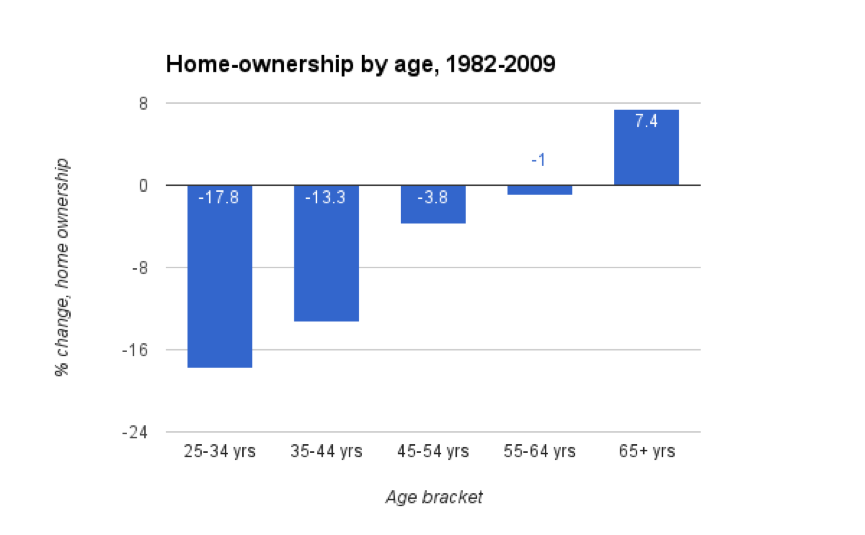ANALYSIS: As a new generation of Australians are locked out of the housing market, an old divide is opening between landowners and renters. The social havoc it brings will play to Labor’s political strengths, writes Ben Eltham.
As media stunts go, the Coalition’s latest was one of the strangest in recent memory.
Desiring a location for his announcement that – surprise! surprise! – the Coalition wouldn’t touch negative gearing for property, the government’s media advisors plumped for the Mignacca family of Penshurst in suburban Sydney.

The Mignaccas, you see, are negative gearers. They own a property and are renting it out at a loss. In return for this apparently illogical investment decision, the government gives them a tax concession.
On the face of it, there’s nothing unusual with this. Paying landlords for making a loss on their investment is how negative gearing works, and it helps to drive up the price of property for everyone.
But the frankly ridiculous aspect of the weekend’s media appearance was the revelation of who the investment property was being purchased for: baby Addison, the Mignacca’s one-year old.
“Kim and Julian Mignacca have used negative gearing to buy property and invest in their family’s future,” Prime Minister Turnbull declared on his Facebook page. It turns out that the Mignaccas have bought an investment property to help set their daughter up for her future.
For the hard-pressed renters of Sydney, this was enraging. Sydney’s property prices are the highest in Australia. As the Mignaccas admitted, they bought an investment property and lived with their parents in order to break into Sydney’s exuberant property market.
The very fact that some families are resorting to buying investment properties for their one-year-olds – merely to enjoy the tax advantages of being a landlord – highlights the absurdity of the current arrangements.
On a recent trip to Sydney, I was astonished at how every conversation eventually returned to housing. The main subject was rent, if only because no-one I met could possibly contemplate buying a property in the Emerald City.
Australia is rapidly transforming into a nation of renters and landlords. It’s a historic sea change from our post-war model of housing, where the majority of Australians owned their own house, and federal and state governments invested heavily in public and social housing.
That model underpinned Australia’s social safety net. Australia has a relatively stingy aged pension when compared to many European countries, and most of our retirement policies still assume that the majority of retirees will own their own homes, and will not have to pay rent into their 70s and 80s.
But that’s changing, fast.
House prices have skyrocketed in recent decades, rising at well above the rates of inflation and average wages. The days when younger Australians on an average wage could afford to buy a house in a big capital city are long gone.

A recent University of New South Wales report found that the average home buyer was priced out of three-quarters of Sydney homes. Even the remnant sliver of affordable housing in the outer suburbs is quickly disappearing. For perhaps the first time since before the Second World War, middle-income Australians look to be locked out of the housing market forever. According to the UNSW’s Bill Randolph, “we’re at a tipping point where Generation Rent will remain Generation Rent forever.”
For those condemned to rent, conditions are bad and getting worse. In contrast to other rich countries, Australia has few protections for private renters. Tenants are routinely denied simple maintenance requests, or the right to keep a pet. If a landlord wants to sell, tenants are forced to let a succession of strangers into their home for inspections. Landlords can and do rotate tenants at 6- and 12-month intervals.
That’s assuming you can get a place at all. The housing affordability crisis for low-income earners in this country is a snowballing public policy crisis. According to Anglicare, just one in 200 rental properties in Sydney is affordable for a family receiving government benefits. Even middle-class wage earners are now being forced to share house. The single biggest spending item in Victoria’s much-lauded recent family violence policy was $152 million for emergency housing.
The medium-term risks are grave. Australia has not endured a recession for a quarter of a century. When unemployment spiked to 11 per cent in 1991, hundreds of thousands of wage earners were thrown out of work. If a similar event occurred now, Australia would quickly face a widespread mortgage crisis, followed by a spike in homelessness, crime and suicides.
But even if there is no recession, business as usual is pretty bad. The slow transformation of a generation of Australians into permanent renters is up-ending many of the old assumptions about Australian politics. It is quietly radicalising millions of generation Y’s and millennials along class and generational lines.
Younger Australians are better educated than any generation before them, and many have worked long periods in unpaid internships to break into a career. Yet they are locked out of the nation’s key source of household wealth generation – even while their parents’ generation reap the benefits of a seemingly ever-rising asset class. To rub in the insult, landlords are enjoying huge tax breaks with their property privilege.
Whether or not you think property in this country is a giant bubble waiting to pop, the social impact of sky-high property prices is manifest. Teachers and nurses can’t afford to live near their schools or hospitals. Low-income earners are sequestered off in ghettos at the edges of our sprawling cities. Generational divides are exacerbated. Inequality is worsening. Class divisions are sharpening.
This sharpening class divide is the reason Labor’s policy on winding back negative gearing has proved so resonant. Younger Australians can see a future where they are increasingly beholden to an elite class of landlords that will control intimate aspects of their everyday lives. They aren’t too happy about that. They are especially unhappy about the billions of dollars worth of tax breaks that are being paid to these landlords, most of whom are quite wealthy.
The potency of the housing debate illustrates one of the structural reasons underpinning the Coalition’s difficult run-up to the federal election. In the Howard years, ever-rising property prices benefited a group of middle-income earners who banked spectacular gains in the value of their family home.
But as prices steepled, the costs of high home prices have moved to the foreground. Australia is a much less equal place than it was in the Howard years. The slide towards a more skewed and imbalanced society has reignited a politics of class division in this country that was long thought to be dormant. We’re not yet seeing Sydney 20-somethings rioting in the streets, but the disaffection with the current housing market is real and deep.
The divisive politics of housing suits Labor, with its focus on inequality and several years worth of well-researched social policy released before the election. In contrast, the issue looks increasingly skewed against the Coalition. Malcolm Turnbull’s embrace of a one-year-old landlord only serves to highlight how out of touch the Coalition has become.
Donate To New Matilda
New Matilda is a small, independent media outlet. We survive through reader contributions, and never losing a lawsuit. If you got something from this article, giving something back helps us to continue speaking truth to power. Every little bit counts.





